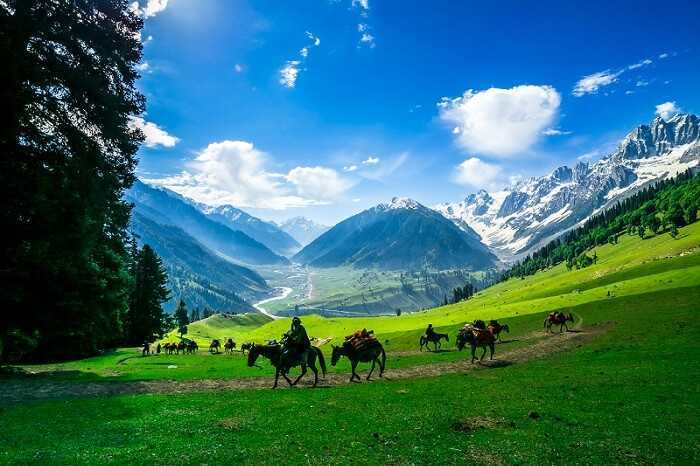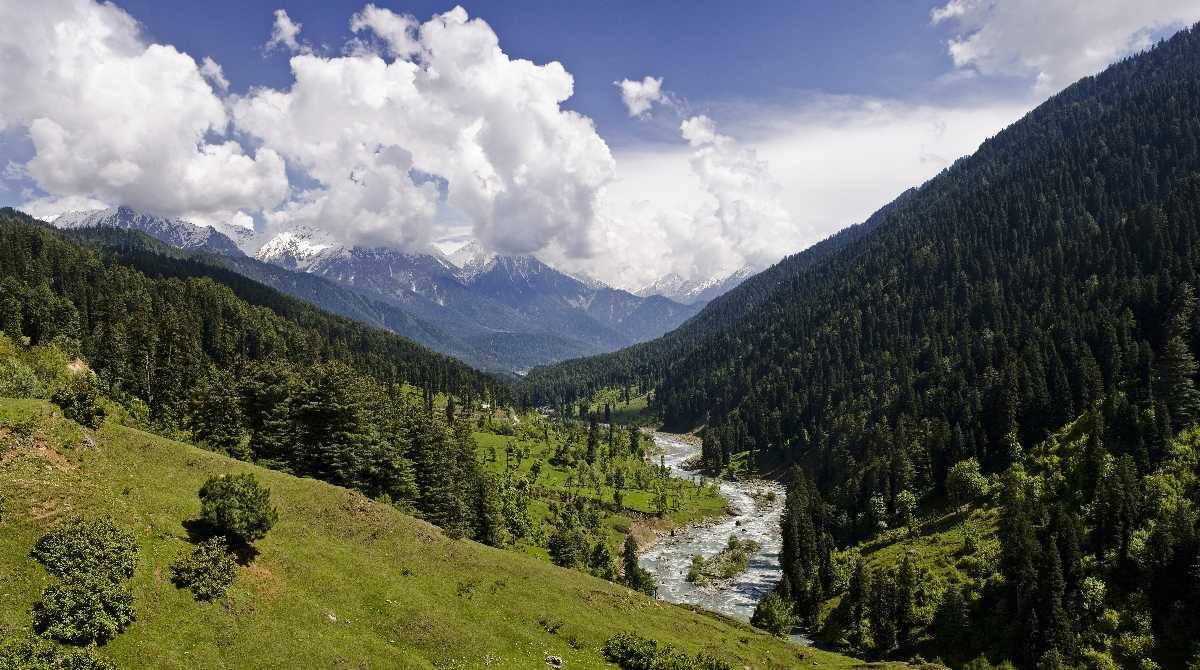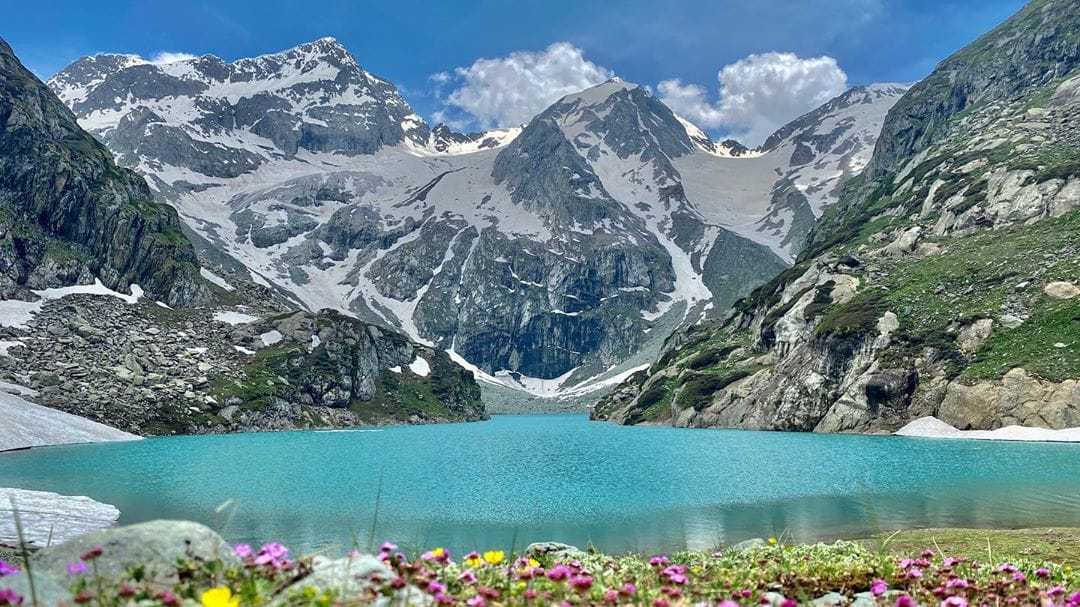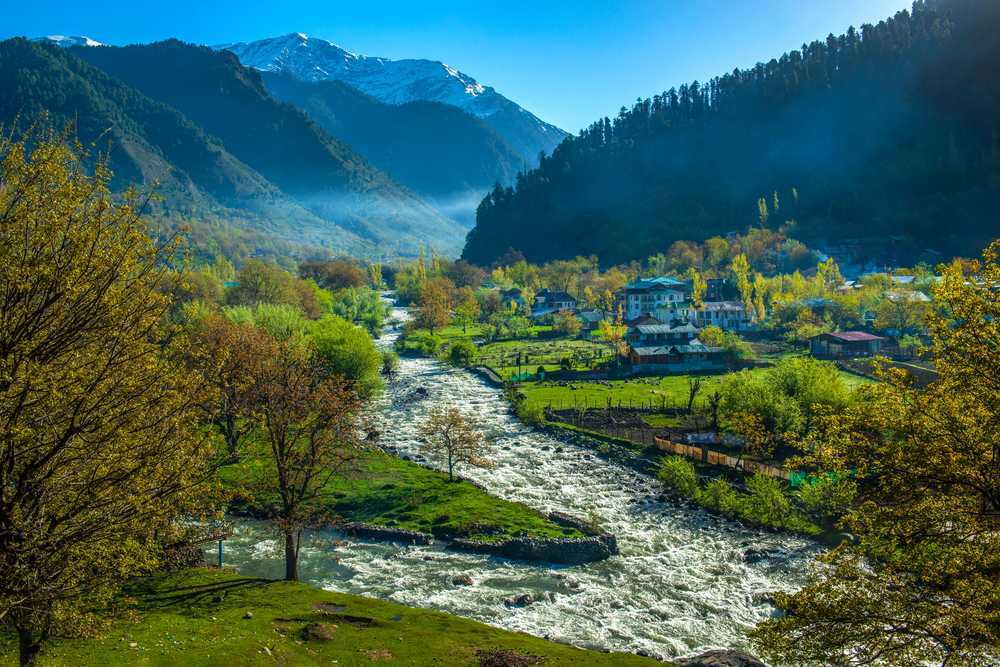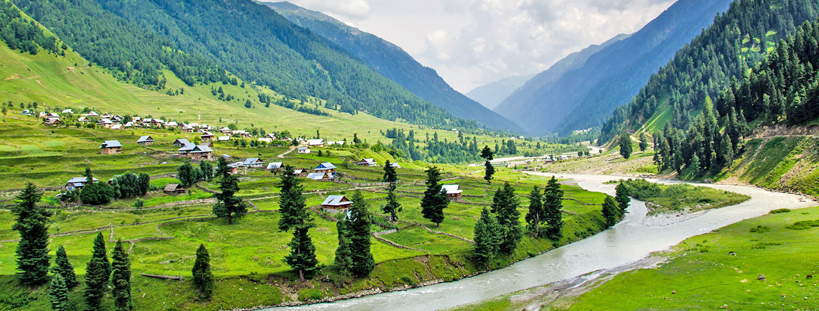AMARNATH CAVE
Have you ever heard of the Amarnath cave? If not, then you, my friend, are missing out on a hilarious and adventurous experience. Imagine trekking through snow-capped mountains, dodging monkeys on the way, just to catch a glimpse of a giant ice lingam (phallic symbol) in a cave. Sounds exciting, right?
Well, for many Hindus, this pilgrimage to the holy Amarnath cave in Jammu and Kashmir is an important part of their spiritual journey. But for others, it's the perfect opportunity to escape their mundane lives and embark on an epic adventure.
Now don't get me wrong - this journey isn't for the faint-hearted. It involves trekking for days at high altitudes while battling altitude sickness and freezing temperatures. But hey, if you're up for it, why not give it a shot?
And let's not forget about the monkeys - they're everywhere! They'll steal your food and water bottles without any warning. So make sure to keep your belongings close or risk going hungry for days.
But once you reach the cave and see that giant ice lingam staring back at you, all your troubles will seem worth it (or maybe not). So pack your bags and get ready for an adventure of a lifetime!
Table of Contents
- Introduction
- History and Culture of Amarnath Cave
- How to Reach and getting around Amarnath Cave
- Weather of Amarnath Cave
- Places to Visit in Amarnath Cave
- Food Options and Local Cuisine of Amarnath Cave
- Best areas for Accommodation in Amarnath Cave
- Shopping in Amarnath Cave
- Nightlife in Amarnath Cave
- Festivals and Events in Amarnath Cave
- Tips for Travelers travelling to Amarnath Cave
- FAQs
History and Culture of Amarnath Cave
Amarnath cave is a sacred Hindu shrine located in Jammu and Kashmir, India. Legend has it that Lord Shiva revealed the secret of immortality to his consort Parvati in this very cave. The cave is situated at an altitude of 3,888 meters and is accessible only during the summer months. The pilgrimage to Amarnath is considered one of the most challenging and spiritually rewarding journeys in India.
The history of the Amarnath cave dates back to ancient times when it was rediscovered by a Muslim shepherd named Buta Malik. Buta Malik was given a bag of coal by a sadhu who turned out to be Lord Shiva himself. When Buta Malik returned home, he found that the bag contained gold instead of coal. Overwhelmed by this miracle, he set out to find the sadhu and discovered the Amarnath cave instead.
Since then, millions of devotees have made their way to the cave every year to pay homage to Lord Shiva. The pilgrimage involves a 45-kilometer trek through treacherous terrain. At the end of the journey lies the ice lingam, a stalagmite formation that symbolizes Lord Shiva's presence in the cave.
Apart from its religious significance, Amarnath also has a rich cultural history. The region is home to several indigenous tribes such as Gujjars and Bakarwals who have lived here for centuries. These tribes have their own unique customs and traditions that are deeply rooted in their relationship with nature.
In conclusion, Amarnath cave is not just a religious site but also an important part of India's cultural heritage. It attracts visitors from all over the world who come here seeking spiritual enlightenment and adventure. Whether you're a devout Hindu or just someone looking for an offbeat travel experience, Amarnath should definitely be on your bucket list!
How to Reach and getting around Amarnath Cave
By Helicopter
One of the quickest and most convenient ways to reach the Amarnath cave is by helicopter. You can take a helicopter from Pahalgam, Baltal, or Srinagar. The journey takes approximately 30 minutes and offers breathtaking views of the Himalayan mountains.
By Trekking
Trekking is a popular option for those who want to experience the scenic beauty of the region. The trek starts from either Pahalgam or Baltal and takes around four to five days. Trekking requires good physical fitness and you should be prepared for unpredictable weather conditions.
By Pony Ride
Pony rides are also available for those who don't want to trek on foot. The pony ride starts from either Pahalgam or Baltal and takes around two to three days. It is a comfortable option, but you need to be careful as the ponies can be unpredictable.
By Road
You can also reach the Amarnath cave by road. The nearest town is Pahalgam, which is well-connected with major cities in Jammu and Kashmir. You can take a taxi or bus from Jammu or Srinagar to reach Pahalgam.
By Train
The nearest railway station to Amarnath cave is Jammu Tawi railway station, which is well-connected with major cities in India. From Jammu Tawi, you can take a taxi or bus to reach Pahalgam.
In conclusion, there are several ways to reach the Amarnath cave, each with its own unique experience. Whether you choose to trek on foot, take a helicopter ride, or travel by road or train, make sure you plan your trip well in advance and prepare accordingly for an unforgettable journey.
Weather of Amarnath Cave












 Extreme Winters
Extreme Winters Mild Winters
Mild Winters Hot + Dry
Hot + Dry Hot + Humid
Hot + Humid Rainy
Rainy Cool and Pleasant
Cool and PleasantAmarnath cave is located in the beautiful state of Jammu and Kashmir, India. The weather in Amarnath cave is unpredictable and can change within minutes. During the summer season, from May to August, the temperature ranges between 15°C to 20°C during the day and drops to as low as 5°C at night. The monsoon season starts from July and continues till September, making it difficult for pilgrims to trek to the shrine.
The best time to visit Amarnath cave is during the months of June and July, as the weather conditions are favorable during this time. The temperature is pleasant with clear skies, making it easier for pilgrims to trek through the mountains. However, it is important to carry warm clothes as it can get chilly at night.
During the winter season, from November to February, heavy snowfall occurs in this region, making it impossible for pilgrims to visit the shrine. In March and April, there are still chances of snowfall which can make trekking difficult.
In conclusion, if you are planning a pilgrimage to Amarnath cave, it is best to plan your visit between June and July when the weather conditions are favorable. It is important to carry warm clothes as temperatures drop significantly at night. Avoid visiting during monsoon season or winter months when heavy rains or snowfall can make trekking impossible.
Places to Visit in Amarnath Cave
- Amarnath Cave: The holy cave is the main attraction of Amarnath, where Lord Shiva is worshipped in the form of an ice lingam. The cave is situated at an altitude of 3,888 meters and is accessible only during the annual pilgrimage season from July to August.
- Sheshnag Lake: Located at a distance of 23 kilometers from the base camp, Sheshnag Lake is one of the most picturesque places in Amarnath. Surrounded by snow-capped mountains and lush greenery, the lake is considered sacred by Hindus and is believed to have been created by Lord Shiva.
- Panchtarni: Panchtarni is a place where five rivers converge, and it marks the halfway point of the Amarnath Yatra. It is believed that Lord Shiva meditated here before proceeding to the holy cave.
- Chandanwari: Chandanwari is located at a distance of 16 kilometers from Pahalgam, and it serves as the starting point for the Amarnath Yatra. The place derives its name from its location amidst fragrant sandalwood trees.
- Baltal Valley: Baltal Valley is another starting point for the Amarnath Yatra, located at a distance of 14 kilometers from Sonamarg. The place offers breathtaking views of snow-clad mountains and meandering rivers.
- Srinagar: Srinagar serves as a gateway to Amarnath, and it offers numerous attractions for tourists. From serene lakes to beautiful gardens, Srinagar has something for everyone.
- Martand Sun Temple: Martand Sun Temple is an ancient temple dedicated to Lord Surya, located near Anantnag. The temple dates back to the 8th century AD and features intricate carvings and sculptures.
- Aru Valley: Aru Valley is located near Pahalgam and offers stunning views of snow-capped peaks, meadows, and forests. The valley also serves as a base camp for trekking enthusiasts who want to explore nearby peaks.
- Betaab Valley: Betaab Valley is named after a Bollywood movie that was shot here in 1983. Located near Pahalgam, Betaab Valley offers breathtaking views of mountains and valleys.
- Sonamarg: Sonamarg translates to "Meadow of Gold" and lives up to its name with its scenic beauty. Located at an altitude of 2,740 meters above sea level, Sonamarg offers panoramic views of snow-clad peaks.
In conclusion, Amarnath offers numerous attractions for tourists who are seeking spiritual enlightenment or simply want to enjoy nature's beauty. Whether it's visiting the holy cave or exploring nearby valleys and lakes, there's something for everyone in this picturesque destination.
Adventures Activities
Religious Shrines
Heritage Places
Hilly Regions
Nearby Forests
Food Options and Local Cuisine of Amarnath Cave
Best areas for accommodation in Amarnath Cave
Amarnath cave, located in the Indian state of Jammu and Kashmir, is a popular destination among Hindu pilgrims. The cave is situated at an altitude of 3,888 meters and is surrounded by stunning natural beauty. If you are planning to visit Amarnath cave, it is essential to choose the right area for your accommodation. Here are some of the best areas for accommodation in Amarnath cave:
- Pahalgam: Pahalgam is a picturesque town located in the Anantnag district of Jammu and Kashmir. It is one of the most popular areas for accommodation near Amarnath cave. The town is surrounded by snow-capped mountains and lush green forests, making it an ideal place to stay for nature lovers.
- Chandanwari: Chandanwari is a small village located at a distance of 16 km from Pahalgam. It is the starting point of the Amarnath Yatra and offers breathtaking views of the surrounding mountains. Chandanwari has several budget hotels and guest houses where you can stay during your visit to Amarnath cave.
- Baltal: Baltal is a scenic valley situated on the banks of the Sindh river. It is located at a distance of 15 km from Sonmarg and serves as a base camp for the Amarnath Yatra. Baltal has several budget hotels and campsites where you can stay during your visit to Amarnath cave.
If you are planning to visit Amarnath cave, here are some properties that you can consider for your accommodation:
- The Khyber Himalayan Resort & Spa: This luxury resort is located in Pahalgam and offers stunning views of the surrounding mountains. The resort has well-appointed rooms, a spa, an indoor swimming pool, and several dining options.
- Hotel Heevan Retreat: This budget hotel is located in Chandanwari and offers comfortable rooms at affordable prices. The hotel has an in-house restaurant that serves delicious local cuisine.
- Baltal Alpine Huts & Camps: This hostel-style accommodation option is located in Baltal and offers tents for travelers who want to experience camping during their visit to Amarnath cave. The campsite has basic facilities like shared bathrooms and dining areas.
Overall, there are several areas for accommodation near Amarnath cave that cater to different budgets and preferences. Choosing the right area will help you make the most out of your trip to this beautiful destination.
Shopping in Amarnath Cave
Amarnath cave, located in the Indian state of Jammu and Kashmir, is a significant pilgrimage site for Hindus. It is believed that Lord Shiva revealed the secrets of creation to Goddess Parvati in this cave. The journey to Amarnath cave is not only a spiritual experience but also an opportunity to indulge in some shopping. Here are some things you can buy, markets to visit and things to avoid during your shopping expedition.
Things to buy
- Pashmina shawls: These luxurious shawls are made from the softest wool and come in various colors and designs.
- Kashmiri spices: The aromatic spices from Kashmir are a must-buy for foodies. You can find saffron, cardamom, cloves, cinnamon, and other spices at reasonable prices.
- Handicrafts: Amarnath cave is famous for its intricate handicrafts made by skilled artisans. You can find wooden carvings, papier-mache items, and embroidered textiles.
- Souvenirs: You can buy souvenirs like postcards, keychains, fridge magnets, and T-shirts as a reminder of your visit to Amarnath.
Markets to visit
- Lal Chowk Market: This bustling market in Srinagar offers a range of products from clothes to electronics. You can also find shops selling traditional Kashmiri handicrafts.
- Floating market: The floating market on Dal Lake is a unique experience where vendors sell their wares on boats. You can find everything from flowers to fruits and vegetables.
- Pahalgam Market: This market is known for its woolen shawls and handmade carpets.
What to avoid
- Cheap imitations: Beware of shops selling cheap knock-offs of genuine products. Always buy from reputed shops or government-run emporiums.
- Bargaining too hard: While bargaining is common in India, don't haggle too hard as it may offend the shopkeeper.
- Excessive spending: Don't overspend on items you don't need or won't use later.
- Non-vegetarian food items: As Amarnath cave is a holy site for Hindus, it's best to avoid non-vegetarian food items while shopping here.
In conclusion, shopping in Amarnath cave is an opportunity to explore the rich culture and heritage of Kashmir while buying souvenirs for yourself or loved ones back home. Just remember to be mindful of what you're buying and where you're buying it from.
Nightlife in Amarnath Cave
Amarnath cave, located in Jammu and Kashmir, is one of the most spiritual and naturally beautiful places in India. It is famous for its annual Amarnath Yatra, where devotees from all over the world come to seek blessings from Lord Shiva. Apart from its religious significance, Amarnath cave offers a unique nightlife experience that one should not miss.
The nightlife in Amarnath cave is different from other popular tourist destinations. It is a perfect blend of spirituality, adventure, and nature. The cool breeze and serene atmosphere make it an ideal place to spend a night under the stars.
Here are three places with activities that one can enjoy during the night:
Amarnath Glacier: A trek to the Amarnath Glacier at night is an adventurous activity that will leave you spellbound. The glacier looks stunning under the moonlight and stars.
Sheshnag Lake: Sheshnag Lake, located at an altitude of 12,000 feet above sea level, is another beautiful spot where you can spend a night camping under the sky. The lake surrounded by snow-capped mountains looks mesmerizing at night.
Mahagunas Pass: Mahagunas Pass is a high altitude pass located at 14,500 feet above sea level. Spending a night camping here is an unforgettable experience. You can witness breathtaking views of snow-capped mountains and glaciers.
In conclusion, spending a night in Amarnath cave is an experience that cannot be missed. The unique blend of nature and spirituality makes it a perfect destination for those seeking inner peace and adventure.
Outdoor Activities in Amarnath Cave
If you're seeking adventure and a glimpse into the natural beauty of Amarnath cave, then there are plenty of outdoor activities that can satisfy your appetite. The area is known for its breathtaking landscapes and stunning views, making it an ideal destination for those who love the outdoors.
One of the most popular activities in Amarnath cave is trekking. The region offers a range of trails that cater to all levels of difficulty, from easy walks to challenging treks. Some of the most popular treks include the Amarnath Yatra trek, which takes you through some of the most scenic parts of the region.
Another activity that is gaining popularity in Amarnath cave is mountaineering. The area has several peaks that are ideal for climbing, including Mount Kolahoi and Mount Haramukh. These mountains offer not only a physical challenge but also incredible views from their summits.
If water sports are more your thing, then you'll be pleased to know that Amarnath cave has plenty to offer in this regard too. Rafting down the Lidder River is an exhilarating experience that will take you through some breathtaking scenery as you navigate rapids and waves.
In summary, Amarnath cave offers a wide range of outdoor activities for those who love adventure and nature. From trekking to mountaineering to water sports, there's something here for everyone. So if you're looking for an unforgettable outdoor experience, make sure to add Amarnath cave to your list!
- Trekking through scenic trails
- Climbing peaks like Mount Kolahoi and Mount Haramukh
- Rafting down Lidder River
Festivals and Events in Amarnath Cave
Festivals and events play a significant role in the spiritual and cultural life of Amarnath cave. Thousands of devotees from across the globe flock to this holy site to participate in various festivals and events that take place throughout the year. These festivals and events not only offer a chance for spiritual rejuvenation but also provide an opportunity to witness the rich cultural heritage of the region.
Some popular festivals and events celebrated at Amarnath cave are:
Amarnath Yatra: It is one of the most significant pilgrimages in India that takes place during the months of June-July (Shravan Month) every year. The pilgrimage entails a trek to the holy Amarnath cave, where devotees seek blessings from Lord Shiva.
Maha Shivaratri: Celebrated during February-March (Phalguna Month), Maha Shivaratri is an important Hindu festival dedicated to Lord Shiva. Devotees fast, pray, and offer water, milk, honey, and bael leaves to Lord Shiva.
Baisakhi: This festival marks the beginning of the harvest season and is celebrated in April every year. Devotees take a dip in the holy Amarnath stream to purify their souls.
Hemis Festival: Celebrated in July-August (Hindu month of Shravan), Hemis Festival is one of the biggest festivals celebrated in Ladakh. It commemorates Guru Padmasambhava's birth anniversary and features traditional music, dance performances, and colorful processions.
Ladakh Festival: Held in September every year, Ladakh Festival is a celebration of Ladakh's rich culture and heritage. The festival features traditional dances, music performances, archery competitions, polo matches, food stalls, and handicraft exhibitions.
In conclusion, festivals and events at Amarnath cave offer a unique blend of spiritual experiences with cultural richness. Participating in these festivals provides an opportunity for visitors to immerse themselves in Ladakhi traditions while seeking blessings from Lord Shiva.
Tips for Travelers while travelling to Amarnath Cave
Plan ahead: Before embarking on the journey to Amarnath cave, it is important to plan ahead. This includes researching the best time to visit, booking accommodations and transportation, and ensuring you have all necessary permits and documents. It is also important to have a backup plan in case of unexpected weather conditions or other unforeseen circumstances.
Pack appropriately: The trek to Amarnath cave can be strenuous and challenging, so it is important to pack appropriately. This includes wearing comfortable clothing and sturdy hiking shoes, carrying enough water and snacks, and bringing a first aid kit. It is also recommended to bring warm clothing as temperatures can drop significantly at night.
Acclimate to the altitude: Amarnath cave is situated at an altitude of over 12,000 feet above sea level, which can cause altitude sickness in some travelers. To avoid this, it is recommended to acclimate slowly by spending a few days at higher altitudes before beginning the trek. It is also important to stay hydrated and avoid alcohol or other substances that can exacerbate altitude sickness.
Respect local customs: The Amarnath Yatra is a sacred pilgrimage for many Hindus, and as such there are certain customs and traditions that should be respected by all visitors. These include dressing modestly, refraining from consuming non-vegetarian food or alcohol during the yatra, and being respectful of religious sites and rituals.
Be prepared for changing weather conditions: The weather in the Himalayas can be unpredictable, with sudden rain or snowstorms occurring at any time of year. Travelers should be prepared for these conditions by carrying waterproof gear and warm clothing even if visiting during summer months. It is also important to stay aware of weather forecasts and make adjustments to travel plans if necessary.
Overall, traveling to Amarnath cave requires careful planning and preparation but can be an incredibly rewarding experience for those who are able to complete the trek safely. By following these tips and being respectful of local customs and traditions, travelers can ensure a safe and enjoyable journey.
FAQs
What is Amarnath cave?
Amarnath cave is a Hindu shrine located in Jammu and Kashmir, India. It is dedicated to Lord Shiva and is one of the most important pilgrimage sites for Hindus. The cave is situated at an altitude of 3,888 meters and can be reached by trekking through the mountains.
How do I get to Amarnath cave?
The journey to Amarnath cave begins from the base camp at Baltal or Pahalgam. From there, you can either trek or take a helicopter ride to reach the shrine. The trek takes around 2-3 days depending on your fitness level and weather conditions.
When is the best time to visit Amarnath cave?
The best time to visit Amarnath cave is during the months of July and August when the shrine is open for pilgrims. The weather during this time is pleasant, and the snow has melted, making it easier to trek.
Is there an age limit for visiting Amarnath cave?
There is no specific age limit for visiting Amarnath cave, but it is recommended that children under five years of age, elderly people above sixty-five years of age, pregnant women, and people with heart or respiratory problems should not undertake this arduous journey.
What should I carry while visiting Amarnath cave?
You should carry warm clothing like jackets, sweaters, gloves, hats, etc., as the temperature drops significantly at higher altitudes. You should also carry comfortable shoes suitable for trekking on uneven terrain. It’s advisable to carry a first aid kit with essential medicines and water bottles.
Is there any accommodation available near Amarnath cave?
Yes, there are various accommodation options available near Amarnath cave ranging from tents to guest houses. However, it's advisable to book in advance as these facilities get booked up quickly during peak season.
Are there any restrictions on taking pictures or videos inside the cave?
Yes, photography and videography are strictly prohibited inside the Amarnath cave due to security reasons. However, you can take pictures outside the shrine area. It's important to respect these rules as they are in place to protect this sacred site.
In conclusion, visiting Amarnath Cave requires some planning beforehand like booking accommodation well in advance and carrying essential items while traveling such as warm clothes and a first aid kit. Pregnant women or people with health conditions should avoid undertaking this journey due to its arduous nature. Visitors must follow rules such as no photography inside the shrine area and respecting local customs that prevail at this sacred site.
